#ann shoemaker
Text
Shockproof

The combination of two filmmakers as distinctive as Samuel Fuller and Douglas Sirk would have made for a much better film than SHOCKPROOF (1949, TCM, YouTube) had Columbia Pictures not softened most of the rough edges of Fuller’s script. He wrote about a parole officer (Cornel Wilde) who becomes obsessed with a murderess (Patricia Knight, aka Mrs. Wilde) under his supervision. He tries to keep her from the gambler boyfriend (John Baragrey) for whom she had killed, gets her a job caring for his blind mother (Esther Minciotti) and, when she shoots a man to protect him, goes on the lam with her., The film still has a strong sense of the forces that drive Wilde from the straight and narrow and a wonderful bit of irony at the end that I can’t reveal. But it also has a hokey ending forced on Sirk and Fuller by the studio. Sirk hated it so much he left Columbia and briefly returned to Germany.
Sirk’s influence can be seen in an opening sequence that introduces Knight by following her picture hat as she adopts a new look and goes for her first check-in with Wilde (in one L.A.’s best. locations, The Bradbury Building). He also makes Wilde’s family home another character in the film (as he did with the family homes in ALL I DESIRE, ALL THAT HEAVEN ALLOWS, THERE’S ALWAYS TOMORROW and WRITTEN ON THE WIND). He tends to favor the story’s women, getting strong performances from Knight (she gives good regret), Minciotti, Ann Shoemaker as a police psychiatrist and Claire Clarkson as Knight and Wilde’s neighbor.
7 notes
·
View notes
Text
No crunking, but lots of haterating and hollerating and even some situations:
BRUTE FORCE (1947): Aptly named prison drama about a group of convicts (including Burt Lancaster, Charles Bickford, and radio actor Howard Duff) in a battle of wills and wits with the sadistic guard captain Munsey (Hume Cronyn). Forcefully directed by Jules Dasssin and certainly vivid, but the few moments of levity the Richard Brooks screenplay provides — such as a droll flashback sequence where former conman Spencer (John Hoyt, who later played Dr. Phillip Boyce in the original STAR TREK pilot) affectionately recalls the slick dame (Anita Colby) who once robbed him with his own gun — serve mostly to demonstrate that there's not enough light moments, even for such a determinedly grim and downbeat story. Worse, since the main action takes place entirely within the prison, women (including Ella Raines, Ann Blyth, and future TV Batgirl Yvonne De Carlo as well as Anita Colby) appear only in brief flashbacks. The film's main attraction is its superb acting — and even Lancaster's brooding sex appeal is somewhat overshadowed by Hume Cronyn's towering performance as the magnificently detestable Munsey. CONTAINS LESBIANS? Nope. VERDICT: Compelling in fits and starts, and Cronyn's Munsey is one of the screen's greatest villains, but it's so oppressive that your attention may start to wander, especially if neither Lancaster nor Cronin is currently onscreen.
HOTEL COCAINE Season 1 (2024): Colorful but sloppy Chris Brancato crime drama, based (apparently very loosely) on the life of a real person, Cuban exile and CIA asset Roman Compte (played, weakly, by Danny Pino), who, as the general manager of Miami's Mutiny Hotel, presided over the heyday of coke-fueled late '70s South Florida hedonism. Brancato uses this as a backdrop for a disappointingly ordinary gangster story, giving Compte a fictional older brother, Nestor Cabal (Yul Vázquez), indistinguishable from Brancato's previous fictionalization of Cuban cop/gangster José Battle Sr. in GODFATHER OF HARLEM (where he was also played by Vázquez), and pitting the brothers against a renegade DEA agent (Michael Chiklis) and an invading Columbian cartel led by Gilberto Henao (Juan Pablo Raba). Despite the title, the Mutiny setting is surprisingly under-utilized; the main plot is cliché-ridden and often listless; and the action is broken up by periodic fits of weird comic relief involving nervous acid-freak hotel owner Burton Greenberg (Mark Feuerstein), including bizarre appearances by Hunter S. Thompson (John Ventimiglia) and Rick James (Larry Powell) in the first two episodes. Pino is barely adequate in the lead, and it sometimes seems like Brancato foolishly expects viewers to find Roman sympathetic, which he really never is, even compared to his antagonists. The only real reasons to bother with the show are its Latina characters, including Roman's spunky teenage daughter Valeria (Corina Bradley); his sympathetic girlfriend Marisol (Tania Watson); and in particular Gilberto's sexy and sadistic Mexican enforcer/girlfriend Yolanda (Mayra Hermosillo). Alas, Laura Gordon is awful as Roman's loyal right-hand woman Janice, while Michael Chiklis, who had made such a strong impression as the antiheroic Vic Mackey on THE SHIELD, is just laughable as DEA agent Zulio. CONTAINS LESBIANS: Not in any meaningful way. VERDICT: Never dull, but too arch to be credible and yet not over the top enough to rival De Palma's SCARFACE, and unlike the similar but better-realized GODFATHER OF HARLEM, it has no particular insights to offer about either its era or its setting.
SEX-POSITIVE (2024): Cute but very dumb sex comedy, directed by Peter Woodward (who also co-scripted with Marie Kirby) about a down-on-her-luck young woman (Katherine Ellis) who moves into a New Orleans commune and, after her initial shock has subsided, becomes part of its loose-knit polycule of ongoing sex parties. The story tries hard to live up to its title, with mixed results: It largely avoids the performative dread sex comedies often evince at the idea of same-gender sex, and it even takes a few flailing stabs at body positivity, but much of its humor is still founded on the idea that people having a lot of (semi-public, maybe mildly kinky) sex is inherently outrageous, which means that if you don't blush and giggle at the mere idea of a sex party, the movie is only occasionally funny. On the other hand, it's refreshing to see a modern sex comedy that doesn't shy away from nudity, allows the characters to actually have sex rather than just talking about it, and doesn't paint the characters' promiscuous lifestyle as a moral failing that has to eventually be recanted. CONTAINS LESBIANS: Yes, although the script leans a little too hard on the idea that anything other than complete sexual fluidity is somehow regressive. VERDICT: In a less prudish cultural climate, a low-wattage comedy like SEX-POSITIVE would barely rate a yawn, but in an era of rampant self-censorship and dreary bourgeoisie repression, its dopey, good-natured smuttiness is sort of endearing.
SUNRISE AT CAMPOBELLO (1960): Okay Dore Schary film adaptation (directed by Vincent Donehue) of Schary's Tony-winning play, starring Ralph Bellamy (reprising his award-winning stage role) as Franklin Delano Roosevelt, recently stricken with infantile paralysis and struggling to decide if he can still have a political future, with Greer Garson as Eleanor, Ann Shoemaker as Franklin's imperious mother Sara, and Hume Cronyn as his friend and political advisor Louis Howe. At first, both Bellamy and Garson seem like they're overplaying their roles, with a bigness more suited to stage than screen; Garson's performance never really stops feeling like caricature, but Bellamy eventually disappears into his part and becomes surprisingly convincing. Cronyn and Shoemaker are both excellent, and extensive use of location shooting (including scenes staged in the Roosevelts' actual homes) keeps the film from feeling objectionably stage-bound, but the narrative's emphasis on the heroism of overcoming chronic illness (a struggle FDR took great pains to conceal as much as possible) is awfully sticky at points, and if you're not American, you may wonder what all the fuss is about. CONTAINS LESBIANS: There have been arguments for years about Eleanor (in particular surrounding her relationship with reporter Lorena Hickok), but you'll find none of that here. VERDICT: As biopics go, it's pretty top-drawer, but if you're not a history buff or don't care about the Roosevelts, it probably won't hold your interest.
#hateration holleration#movies#teevee#brute force#mark hellinger#burt lancaster#hume cronyn#john hoyt#chris brancato#hotel cocaine#mayra hermosillo#michael chiklis#danny pino#yul vazquez#mark feuerstein#sex-positive#peter woodward#katherine ellis#sunrise at campobello#dore schary#ralph bellamy#greer carson#ann shoemaker#franklin delano roosevelt#eleanor roosevelt#the main reason to watch hotel cocaine is mayra hermosillo#who is distractingly hot#shame about the show#it does also have#tania watson
3 notes
·
View notes
Text

Bad movie I have My Favorite Wife 1940
#My Favorite Wife#Cary Grant#Irene Dunne#Randolph Scott#Gail Patrick#Ann Shoemaker#Scotty Beckett#Mary Lou Harrington#Donald MacBride#Hugh O'Connell#Granville Bates#Pedro de Cordoba#Jean Acker#Murray Alper#Leon Belasco#Joe Cabrillas#Bill Cartledge#Chester Clute#Corky#Franco Corsaro#Florence Dudley#Hal Gerard#Roque Guinart#Earle Hodgins#Edna Holland#Thelma Joel#Cy Kendall#Donald Kerr#Max Linder#Ellen Lowe
2 notes
·
View notes
Text





The Return of the Whistler (1948) D. Ross Lederman
June 22nd 2024
#the return of the whistler#1948#d. ross lederman#michael duane#lenore aubert#richard lane#james cardwell#ann shoemaker#olin howland#otto forrest
0 notes
Text
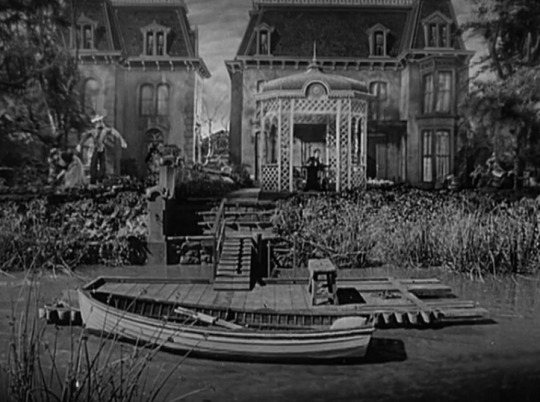
Abgesehen davon, daß das Haus sich nur mittels sehr durchschaubaren Trickaufnahmen am Fluss befindet ist Fritz Langs für Fritz-Lang-Verhältnisse eher unaufwändigen noir-Krimchen House by the River schön stimmungsvoll und gemein. Der moralisch zweifelhafte erfolglose Schriftsteller ermordet, im Haus, während dem Versuch sich ihr amourös zu nähern, versehentlich das Dienstmädchen und versenkt es gemeinsam mit seinem gutmütigen Bruder -Sie ahnen es- im Fluss, zeigt sich fürderhin von seiner unangenehmsten Seite und hat keine Skrupel, die Schuld dem Bruder in die Schuhe zu schieben. Der lässt es sich gefallen, weil er seine Schwägerin liebt. Alles recht verfahren. Und immer entweder im Haus. Oder am Fluss. Wird wohl am Ende die Gerechtigkeit siegen? Im Gerichtssaal? Fluss? Haus?
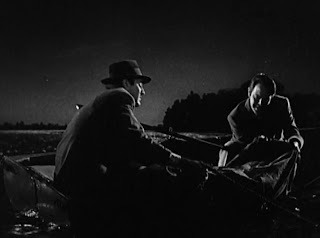
#House by the River#Louis Hayward#Lee Bowman#Jane Wyatt#Dorothy Patrick#Ann Shoemaker#Film gesehen#Fritz Lang
0 notes
Photo

#sunrise at campobello#ralph bellamy#greer garson#hume cronyn#jean hagen#ann shoemaker#alan bunce#vincent j. donehue#1960
0 notes
Photo

benbenbenmaria
8 notes
·
View notes
Text
How did women manage to hide their gender at sea?
That is a really interesting thing when you consider that there were some who pretended to be men in order to be able to serve on a ship and even managed to remain undiscovered for a longer period of time. Certain circumstances played into their hands. For one thing, the crew, many of whom were boys or young men from about 9 to their mid-20s.Together with the clothing, which consisted of a loose shirt, a waiscoat or jacket, baggy trousers or petticoat breeches and a handkerchief around the neck, made it easy for the women to hide their curves. And since everyone wore their hair tied up long in a pigtail or ponytail, it wasn't very noticeable either. But what many had to do was, if their breasts were too big, to tie them flat so that they didn't stand out. So they were just mistaken for a young man in his teens or early twenties. Like Ann Johnson, the daughter of a shoemaker, who even served as Able Seaman in 1849. Her appearance was described as that of a handsome boy aged 16-17, even though she was already in her twenties.
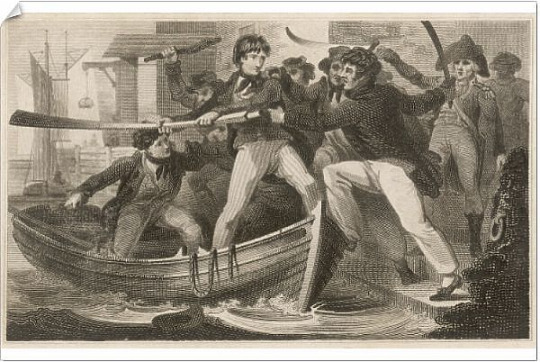
Mary Ann Talbot (1778 - 1808) donned male clothes and enlisted as a sailor during the Napoleonic Wars; she was wounded in 1794 and later captured by the French. She returned to London in 1796 but the following year was seized by a pressgang, shown here, and was forced to reveal her gender (x)
A much bigger problem was the daily need to go to the toilet. Because these facilities were more than primitive on a ship and rather practical in nature, because if it was necessary, well, then they just peed over the railing or used a urinal. Otherwise the men went to the head. The area in the bow behind the figurehead that served as a toilet. Many probably always went to the head, but it is also known that some used a small tunnel made of horn or metal as an aid to avoid attracting attention.
You would think that the ladies would have one more thing that would expose them. Because a comrade who bled once a month for a good week was something unusual. But there are no notes in historical writings about it. According to historians today, there are three theories. One is that the women on board lived such ferociously active lives that, like modern athletes in training today, they may have ceased to have periods. In case of prepubescent girls, the hard life and poor diet could have delayed the onset of puberty for several years. Another theory is that so many seamen suffered from a range of diseases and ailments including piles and gonorrhea that they were not likely to comment on one of their number having bloodstained clothing on occasion.
Considering these points, it was quite possible for women to pretend to be men and hide their true gender in order to serve as sailors at sea.
1K notes
·
View notes
Note
Considering we're kinda still on the topic of Jartnell, what do you think his relationship was like with his parents? Just putting it out there.
I live in a constant state of being on the topic of Jartnell. o7
Ohhh man, I really wish I knew how his relationship was with his dad. He was only thirteen when his dad died, and very, very little is known about Thomas Hartnell Senior. The only things I've been able to find about him were a very tiny obituary after his death, a mention in Sarah's will bequeathing his pocket watch to Charles, and an apprenticeship record when he still lived near Portsmouth. Other than that, I don't know what he was like, how much he worked, how he treated his children, or any of it. I do know Sarah never got remarried after his death, but I never found a reason as to why.
Also, here's his and Sarah's epitaph:
IN MEMORY OF
THOMAS HARTNELL
LATE SHIPWRIGHT IN H. M. YARD
CHATHAM
WHO DIED APRIL 23rd 1832 AGED 43 YEARS
AND OF SARAH HIS WIFE
WHO DIED MARCH 30th 1854 AGED 61 YEARS
"It is better to trust in the Lord than to
put confidence in Man"
Yikes about that quote. :'|
I do think John probably felt a lot of pressure to fill his dad's role after he was gone. He had a family to look after, and he took up his own apprenticeship almost immediately after his dad's death.
As to his relationship with his mom, I think he loved her, and she clearly loved him and his brother per her letter to them. She wanted so badly to her see her children again and was scared and miserable at the prospect that she might not live that long, or that something terrible had happened to them. She told them how much she missed them, and gave them gossip about their family and friends because she knew they'd want to know about it. I think she really was the 'affectionate Mother', and I'm hoping their relationship was good even as hard as their lives were.
The only hiccup I've ever seen between them (and it might not even be a big deal) was that John didn't assign his Volage ship's pay to Sarah, but instead to his younger sister Mary Ann. I have no idea why this was; maybe he and his mom went through a rough patch when he gave up shoemaking and went on to be a sailor, or maybe Mary Ann needed the money, orrrr maybe he trusted Mary Ann with it for some reason. I can't say, because I haven't seen any letters exchanged between them during this period in his life.
So, I really can't say for sure how he felt about his parents, aside from what evidence we have documented already. People in the past are always complex creatures, but they're also just human. I think John, like any oldest son, had up-and-down feelings over the years and per situations. But I also think when it came down to it, he loved his parents and they loved him.
10 notes
·
View notes
Text
Duggar-Wissmann Wedding Guest Sightings Part 3

Joseph and Justus Duggar

Emerson and Jackson Bates

Susanna (Wissmann) and Drew Jerred and baby

Nathan, Esther, and Kenna Bates

Joseph Shoemaker (MEDIC Corp)

James Duggar, Claire and Emma Langdon

The Smiths (sister of Hilary Spivey)

Laura Demasie, Langdon Sisters, Gari-Anne Smith

Hilary Spivey and Gari-Anne Smith

Brandon Smith and Noah Robinson
7 notes
·
View notes
Text
Birthdays 4.28
Beer Birthdays
Ernst F. Baruth (1842)
Louis F. Neuweiler (1848)
Tom Ciccateri (1956)
Carl Kins (1956)
Michael Demers (1966)
Abram Goldman-Armstrong (1978)
Five Favorite Birthdays
Ann-Margret; actor, singer (1941)
Kurt Gödel; Austrian mathematician (1906)
Harper Lee; writer (1926)
James Monroe; 5th President of the US (1758)
Terry Pratchett; writer (1948)
Famous Birthdays
Jessica Alba; actor (1981)
Robert Anderson; playwright (1917)
Dick Ayers; author and illustrator (1924)
Hertha Marks Ayrton; Polish-British mathematician and physicist (1854)
Jimmy Barnes; Scottish-Australian singer-songwriter (1956)
Lionel Barrymore; actor (1878)
Bart Bok; astronomer (1906)
Roberto Bolaño; Chilean novelist (1953)
Blake Bortles, American football QB (1992)
Charles Caleb Cotton; English writer (1630)
Carolyn Cassady; author (1923)
Willie Colón; Puerto Rican-American trombonist (1950)
Charles Cotton; English poet and author (1630)
Penelope Cruz; actor (1974)
Paul Guilfoyle; actor (1949)
Marie Harel; French cheesemaker (1761)
Jinky the Fruit Bat; character on David Letterman
Carolyn Jones; actor (1929)
Steve Khan; jazz musician (1947)
Bruno Kirby; actor (1949)
Yves Klein; French painter (1928)
Sylvestre François Lacroix; French mathematician (1765)
Ferruccio Lamborghini; Italian businessman (1916)
Jay Leno; comedian, television talk show host (1950)
José Malhoa; Portuguese painter (1855)
Melanie Martinez; singer (1995)
Mary McDonnell; actor (1952)
James Monroe 5th U.S. President (1758)
Bridget Moynahan; actor (1971)
Nezahualcoyotl; Acolhuan philosopher, warrior, poet and ruler (1402)
Robert Oliveri; actor (1978)
Jan Oort; Dutch astronomer (1900)
Alberto Pirelli; Italian manufacturer (1882)
Ian Rankin; Scottish author (1960)
Nate Richert; actor (1978)
Oskar Schindler; Czech-German businessman (1908)
Karl Barry Sharpless; chemist (1941)
Eugene Merle Shoemaker; geologist and astronomer (1928)
Madge Sinclair; Jamaican-American actress (1938)
Sidney Toler; actor (1874)
Tristan Tzara; Romanian-French poet (1896)
Alice Waters; chef (1944)
Kari Wuhrer; actor (1967)
4 notes
·
View notes
Photo

Fred Astaire and Ginger Rogers in Shall We Dance (Mark Sandrich, 1937)
Cast: Fred Astaire, Ginger Rogers, Edward Everett Horton, Eric Blore, Jerome Cowan, Ketti Gallian, William Brisbane, Ann Shoemaker, Harriet Hoctor. Screenplay: Allan Scott, Ernest Pagano, P.J. Wolfson. Cinematography: David Abel. Art direction: Van Nest Polglase. Film editing: William Hamilton. Music: George Gershwin.
This was the seventh teaming of Fred Astaire and Ginger Rogers, and the fatigue is beginning to show, despite a score by George Gershwin and songs with his brother Ira. Shall We Dance is marred by a tired script that reworks the familiar pattern: The Astaire and Rogers characters meet cute, feel an attraction to each other that they resist, find themselves in farcical misunderstandings, and several spats, songs, and dances later assure themselves that they are in love. In this one, Astaire plays a faux-Russian ballet dancer called Petrov -- he's actually Pete Peters from Philadelphia, Pa. -- who really wants to be a tap dancer. The idea of Astaire as a danseur noble is absurd from the start, and Astaire knew it -- he had turned down the lead in the 1936 Broadway production of the Richard Rodgers and Lorenz Hart musical On Your Toes, which like Shall We Dance centers on a production that combines ballet with Broadway-style dance. Gershwin, too, was not entirely happy about the idea of composing ballet music, but both men were eventually persuaded to go along with the idea. The plot gimmick is that Peters/Petrov has fallen for tap dancer Linda Keene, who initially spurns him, and through a series of mishaps the rumor gets started that the two are secretly married. After much ado, they really get married so she can divorce him and put a stop to the rumors, but by then they of course have really fallen in love. One problem is that, unlike the best Astaire-Rogers films, Top Hat (Mark Sandrich, 1935) and Swing Time (George Stevens, 1936), the songs in Shall We Dance don't grow organically out of the screenplay. They have to be wedged in, like Astaire's number "Slap That Bass," which takes place in the engine room of the ocean liner on which Petrov and Linda are traveling -- one of the oddest of the Big White Sets for which the Astaire-Rogers musicals were famous: It's the cleanest engine room ever seen. The biggest Astaire-Rogers dance duet in the film is "Let's Call the Whole Thing Off," which is performed on roller skates in a park when Petrov and Linda try to evade pursuing reporters; it, too, seems designed more to get Astaire and Rogers on skates than to contribute to the plot. On the other hand, there's an obvious missed opportunity for a romantic duet to the Oscar-nominated song "They Can't Take That Away From Me," which Astaire sings to Rogers, but he doesn't follow through by dancing with her. He does dance to a few bars of the song when it's reprised later in the film, but his partner is Harriet Hoctor, a dancer whose specialty was a deep back-bend that she performed while en pointe. There's a sequence in which Hoctor does her thing while dancing backward toward the camera, which she is facing, that's flat-out creepy. Astaire-Rogers film regulars Edward Everett Horton and Eric Blore are on hand to do their usual fussbudget routines. Blore's bit in which he tries to tell Horton over the phone that he's been arrested and is at the Susquehanna Street Jail, constantly being interrupted in his attempts to spell "Susquehanna," is the film's funniest moment.
3 notes
·
View notes
Text
Film Awards Season Check-In
In early October the field was looking light as only three studios released their screening schedules early: Amazon, Netflix and Searchlight. Now that we are in early November more studios have entered the fray and/or readying their boards.
Sony is putting forth THE WOMAN KING, DEVOTION, the Whitney Houston biopic I WANNA DANCE WITH SOMEBODY, LYLE, LYLE CROCODILE, Tom Hanks' A MAN CALLED OTTO and WHERE THE CRAWDADS SING; and new to the mix Mark Wahlberg's FATHER STU.
So far THE WOMAN KING and DEVOTION have had a number of screenings with DEVOTION (based on the true story of the friendship between pilots played by Glen Powell (who is an executive producer on the film) and Jonathan Majors) getting special treatment with a screening hosted by Amanda Seyfried.
Sony's indie arm Sony Pictures Classic has put up the films they are pushing: documentaries: HALLELUJAH: LEONARD COHEN, A JOURNEY, A SONG; JAZZ FEST: A NEW ORLEANS STORY, Luca Guadagnino's SALVATORE: SHOEMAKER OF DREAMS, THE RETURN OF TANYA TUCKER, TURN EVERY PAGE- THE ADVENTURES OF ROBERT CARO AND ROBERT GOTTLIEB and narrative films, Florian Zeller's THE SON (which is connected to Zeller's THE FATHER, which earned Anthony Hopkins an Oscar) starring Hugh Jackman; two Cannes screened films: RETURN TO SEOUL and ONE FINE MORNING and the English-language remake of Akira Kurusawa's IKIRU - LIVING starring Bill Nighy
When TOP GUN: MAVERICK screened at CinemaCon a few critics in attendance said it was a Best Picture candidate and I guess Paramount feels the same as TG:M and Damian Chazelle's LALA LAND follow-up BABYLON are the only films they are putting forward. IIRC this is a one-picture improvement over 2019 as that year ROCKETMAN was the only film they put forward. TG:M has quite a few screenings lined up (with no Q&A component so far because Tom Cruise isn't going to beg for a nomination) with zero, as of yet, for BABYLON.
Focus Features has put up ARMAGEDDON TIME starring Anne Hathaway and Jeremy Strong, DOWNTON ABBEY: A NEW ERA, HONK FOR JESUS. SAVE YOUR SOUL (which had a brief theatrical release while streaming on Peacock), MRS. HARRIS GOES TO PARIS, THE NORTHMAN (with alleged new father or soon-to-be-father Alexander Skarsgaard), the fantastic THE OUTFIT, THE SILENT TWINS starring Letitia Wright and Tamara Lawrance, YOU WON'T BE ALONE and TAR with Cate Blanchett who is sure to be the front runner in the Lead Actress category.
Universal has released the titles they are putting forward: Steven Spielberg's film a'clef THE FABLEMANS, the true story of the women who crafted the article to expose Harvey Weinstein, the Carey Mulligan starrer SHE SAID, NOPE, BROS and animated films MINIONS: THE RISE OF GRU, PUSS IN BOOTS: THE LAST WISH and THE BAD GUYS.
Disney had their slate up for some time but have only just recently added James Cameron's AVATAR: THE WAY OF WATER and Rihanna's offering for WAKANDA FOREVER, "Lift Me Up"; a song written by Rihanna, the film's director Ryan Coogler and film's composer Ludwig Göransson. "Lift Me Up" joins Giveon's "Time" from AMSTERDAM as the possible Best Song candidates the studio has put forward.
WB's schedule has been static with six films put forward (THE BATMAN, DON'T WORRY DARLING, FANTASTIC BEASTS: THE SECRETS OF DUMBLEDORE, the documentary NAVALNY, DC LEAGUE OF SUPERPETS and ELVIS). The only movement is that they keep adding Q&As for Austin Butler. They're working him like Colonel Parker did Elvis.
What I Have Seen So Far:
NETFLIX
The Good Nurse
Wendell & Wild
Bardo: False Chronicle of a Handful of Truths (Mexico's Oscar submission)

Guillermo Del Toro's Pinocchio
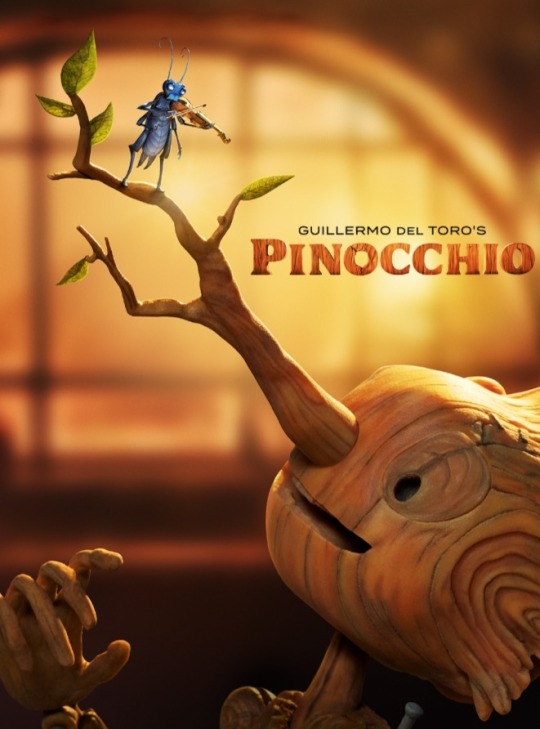
(Q&A last weekend with Guillermo del Toro, co-director Mark Gustafson, stars Gregory Mann, Christoph Waltz and Finn Wolfhard)



Lady Chatterley's Lover
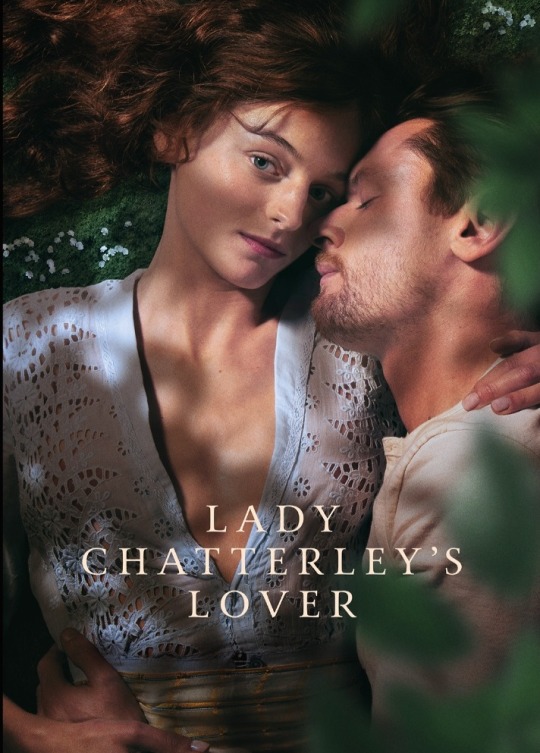

(Q&A with Emma Corrin and director Laure de Clermont-Tonnere)

The Wonder
-A late addition to their slate is Scott Cooper's THE PALE BLUE EYES; the directors third film with Christian Bale. Disney has AMSTERDAM up as part of 20th Century and are putting Bale and his costars but it appears Bale is stumping for this instead, with a Q&A with Cooper and his costars Lucy Boynton and Henry Melling this week.
AMAZON
My Policeman
SEARCHLIGHT
The Banshees of Inisherin
Empire of Light
FOCUS FEATURES
TÁR
Armageddon Time
SONY
The Women King
(Q&A with Composer Terence Blanchard, Editor Terilyn Shropshire, Cinematographer Polly Morgan, Viola Davis and her husband/producing partner Julius Tennon and director Gina Prince-Bythewood)


UNITED ARTISTS
Till
Women Talking
Bones and All
(Q&A with producer Peter Spears, composers Atticus Ross & Trent Reznor, writer David Kajganich, Taylor Russell and director Luca Guadagnino)



SRAB FILMS
Saint Omer (France's Oscar submission)
(Q&A with director Alice Diop)

#movies#movie talk#awards season#alice diop#guillermo del toro#guillermo del toro's pinocchio#finn wolfhard#luca guadagnino#taylor russell#bones and all#bones & all#trent reznor#emma corrin#lady chatterley's lover#viola davis#gina prince bythewood#gina prince-bythewood#the woman king#awards season check-in
3 notes
·
View notes
Text


Hans Christian Andersen's life was marked by a series of significant challenges and achievements, which shaped both his character and his work:
Early Life:
Birth and Family Background:
Andersen was born on April 2, 1805, in Odense, Denmark, into a poor family. His father, Hans Andersen, was a shoemaker, and his mother, Anne Marie Andersdatter, worked as a washerwoman. They lived in a small, humble home, and their financial situation was precarious.
Andersen’s father had some education and a love for literature, which he passed on to his son, reading him stories and introducing him to books like "Arabian Nights." However, his father died when Andersen was only 11 years old, leaving the family in even more difficult circumstances.
Education and Early Struggles:
Andersen’s formal education was limited and sporadic during his early years due to his family’s poverty. He was an awkward and sensitive child, often teased by other children. His mother, who was illiterate, hoped he would become a tailor or some other tradesman, but Andersen was determined to pursue a career in the arts.
At the age of 14, Andersen moved to Copenhagen, the capital of Denmark, to try his luck as an actor, singer, and writer. He had little money and no connections, and the first few years in the city were extremely difficult. He faced numerous rejections and often struggled to make ends meet.

Breakthrough and Career
Patrons and Education:
Andersen’s fortunes began to change when he gained the attention of influential patrons, including Jonas Collin, a director at the Royal Danish Theatre. Collin arranged for Andersen to receive a formal education, which he began at the age of 17, though his time at school was challenging. He was much older than his classmates, and the rigid academic environment stifled his creativity.
Despite these difficulties, Andersen persevered and continued to write. His first major success came with the publication of his poem "The Dying Child" in 1827.
Literary Success:
Andersen gradually found success as a writer, particularly with his plays, novels, and travelogues. However, his true breakthrough came in the 1830s and 1840s with the publication of his fairy tales, which eventually made him famous.
His tales, such as "The Little Mermaid," "The Ugly Duckling," and "The Emperor's New Clothes," became beloved classics. These stories, often infused with melancholy and moral complexity, reflected both his personal struggles and his deep empathy for the downtrodden.

Later Life:
Loneliness and Personal Struggles:
Despite his success, Andersen’s personal life remained difficult. He never married and had no children, and there is evidence to suggest that he experienced unrequited love several times, both for men and women. This emotional isolation is often reflected in his stories, which frequently explore themes of loneliness and longing.
Andersen’s relationships with others were often strained; he was known to be sensitive to criticism and somewhat difficult in his personal dealings. Despite his fame, he often felt insecure and misunderstood.
Recognition and Travel:
Andersen became one of the most famous writers of his time and was celebrated across Europe. He traveled extensively, visiting countries like Germany, Italy, England, and France, and his travelogues were also well-received. His literary fame brought him into contact with many notable figures of the era, including Charles Dickens, with whom he had a complicated friendship.
Despite his international recognition, Andersen always felt a strong connection to Denmark, and he remained rooted in his native country.

Death and Legacy:
Final Years:
Andersen continued to write and publish stories until his death. In his later years, he suffered from various health issues, including liver cancer, and he died on August 4, 1875, in Copenhagen.
Andersen was honored in Denmark and internationally, with memorials and tributes celebrating his contributions to literature. His stories, which often speak to universal themes of human experience, have continued to resonate with readers around the world.
Legacy:
Today, Hans Christian Andersen is remembered as one of the greatest storytellers of all time. His fairy tales have been translated into more than 125 languages and continue to be adapted into various forms of media, including films, plays, and ballets.
Andersen's life, filled with hardship, resilience, and creativity, is mirrored in the depth and poignancy of his tales. His ability to transform personal pain into stories that speak to the human condition has secured his place as a literary giant


Hans Christian Andersen was a voracious reader with a wide range of literary influences. Some of the authors and works he admired and enjoyed reading include:
William Shakespeare:
Andersen had a deep admiration for Shakespeare, whose works he encountered during his travels and studies. Shakespeare’s plays, with their complex characters and exploration of human emotions, left a lasting impression on Andersen. This influence can be seen in the dramatic and sometimes tragic elements of Andersen’s own stories.
Miguel de Cervantes:
Andersen was a fan of "Don Quixote" by Cervantes. The novel’s blend of humor, adventure, and a deeper commentary on idealism versus reality likely resonated with Andersen, who often explored similar themes of dreams and the harshness of reality in his tales.
Walter Scott:
The works of the Scottish author Walter Scott, especially his historical novels, were influential to Andersen. Scott’s ability to blend history with fiction and his vivid storytelling appealed to Andersen’s love for narrative and history.
Ludwig Tieck:
Andersen was influenced by the German Romantic writer Ludwig Tieck, whose fairy tales and novellas often contained elements of the supernatural, irony, and a blend of the fantastical with the everyday. Tieck’s ability to mix the magical with the mundane had a strong impact on Andersen’s own fairy tale style.
E.T.A. Hoffmann:
Another German Romantic writer, E.T.A. Hoffmann, known for his dark and whimsical tales, was an author Andersen admired. Hoffmann’s ability to create stories that were both eerie and enchanting likely inspired Andersen’s own use of similar atmospheres in his tales.
Jean-Jacques Rousseau:
The philosophical works of Rousseau, particularly his ideas on nature and education, influenced Andersen. Rousseau’s emphasis on the importance of childhood and natural innocence resonated with Andersen, who often depicted children as central figures in his stories.
The Brothers Grimm:
Although Andersen’s fairy tales are often distinct in style from those of the Brothers Grimm, he was aware of their work and respected their contributions to the tradition of folk and fairy tales. Their collection of German folktales was part of the broader literary landscape that influenced Andersen.
Ovid:
Andersen read classical literature, including the works of the Roman poet Ovid. "Metamorphoses," with its themes of transformation and myth, likely influenced Andersen’s own stories, where characters frequently undergo significant changes, both physical and emotional.
Johann Wolfgang von Goethe:
Andersen admired Goethe, especially his literary works that blended philosophy, drama, and poetry. Goethe’s exploration of the human soul and the natural world left a strong impact on Andersen’s writing.
Hans Sachs:
The works of Hans Sachs, a German meistersinger, and poet, were also among Andersen’s readings. Sachs’s combination of folklore, humor, and social commentary might have contributed to Andersen’s approach to storytelling, where he often combined humor with more serious themes.

Literary Tradition:
Folklore Influence: Andersen was influenced by the oral tradition of folklore, which often included dark and cautionary elements. Many traditional fairy tales and folk stories were intended to teach moral lessons through fear and vivid depictions of the consequences of bad behavior or unfortunate circumstances.
Realism and Morality: Unlike the more sanitized versions of fairy tales that became popular later, Andersen's stories do not shy away from the harsh truths of life. He wanted his tales to resonate with both children and adults, and he believed that including darker elements made the stories more realistic and morally instructive.
Cultural Context:
19th-Century Sensibilities: Andersen wrote during the 19th century, a time when literature often grappled with themes of mortality, suffering, and the struggles of the human condition. The Romantic movement, which influenced Andersen, emphasized intense emotion and often included tragic or melancholic themes.
Artistic Vision:
Emphasis on Suffering and Redemption: Many of Andersen's tales focus on the idea of suffering leading to eventual redemption or transformation. For example, in "The Little Mermaid," the protagonist endures great pain and ultimately sacrifices her life for love, which leads to her spiritual redemption. This focus on suffering as a path to spiritual growth or moral improvement is a recurring theme in his work.
Complex Characters and Themes: Andersen's characters are often more complex and morally ambiguous than those in other fairy tales. This complexity allows for stories that explore the dualities of life, such as joy and sorrow, beauty and ugliness, or love and loss.
The darkness in Andersen's tales is a reflection of his belief that life is a blend of beauty and pain, joy and sorrow. By incorporating these elements into his stories, he created works that are emotionally resonant and enduring, appealing to both children and adults across generations.

1 note
·
View note
Text

ELECTRIQUE BOUTIQUE #1, 10/20/23
Stream/download above
Please note that the first few episodes of the show are not great--sound quality/mixing is not quite there yet, and my talking is kind of choppy and awkward. Nevertheless, I'm keeping them available--but maybe start with one of the more recent episodes if this is your first time hearing the show. Thanks!
The first episode of Electrique Boutique! We dive into the world of minimal synth, lo-fi and DIY electronic music, cold wave, post punk, and whatever else might find its way under that categorical umbrella. Our intro music is “Michael Jackson” by Negativland, and our theme music is “The Taxi” by Young Marble Giants. Listen live every other Friday, 6-8 PM at hollowearthradio.org
Image: Vyto B
TRACKLIST:
Carol - “So Low” (1981) 0:03:02
Drinking Electricity - “Good Times” (1982) 0:06:39
Throbbing Gristle - “Hot On the Heels of Love” (1979) 0:10:10
Portray Heads - "浮遊体" (1986) 0:14:27
Mamman Sani - “Tunan” (1978) 0:19:36
Young Marble Giants - “NITA” (1980) 0:24:20
Bale Paré - “Palais D’amour” (1985) 0:27:49
Ann Steel & Roberto Cacciapaglia - “Portrait” (1979) 0:31:24
Moebius - “Hasenheide” (1983) 0:35:46
Güner Künier - “Elimi Tut Dedim Sana” (2022) 0:38:21
XV - “Tasmanian Angels” (2023) 0:43:01
Operating Theatre - “Spring is Coming With a Strawberry in the Mouth” (1986) 0:45:45
Ritza - “Ard Fadya” (2019) 0:50:04
Majid Soula - “Win Terram” (1982) 0:54:14
Das Schwäche - “Das Schwäche” (1979/2011) 0:58:16
Cleo McNett - “Snap” (1982) 1:06:19
Obsolencia Programada - Repulsion (2021) 1:11:40
Die Doraus und Die Marinas - “Einkauf” 1:14:41
Peine Perdue - “Paradis” (2015) 1:17:41
Marina Zispin - “Ski Resort” (2023) 1:22:01
Vyto B - “Tricentennial 2076” (1976) 1:27:04
Ceramic Hello - “A Grey Man” (1981) 1:30:42
Deux - “Game and Performance” (1983) 1:32:35
DAF - “Liebe Auf den Ersten Blick” (1981) 1:36:04
Hierophants - “Shoemaker Levy 9” (2019) 1:40:04
Cluster - “Heiße Lippen” (1974) 1:43:03
Mort Garson - “Symphony For a Spider Plant” (1976) 1:45:25
Broadcast - “America’s Boy” (2005) 1:48:06
Karen Marks - “Problem Page” (1981) 1:55:12
1 note
·
View note
Photo

Die jungen Leute stellen -völlig unerwartet- eine Show auf die Beine, diesmal eine besonders melodramatischen mit Kostümen, wie die Altvorderen sie in den fröhlichen Neunzigern trugen. “Mein Held” sagt Judy hier zu Mickey, während der Schurke am Boden liegt. Selbstredend dient dieses einem guten Zweck, nämlich Mickeys gutem, ehrlichen, amerikanischen Tanzorchester Fahrkarten nach Chicago zu finanzieren, wo ein Wettbewerb für den guten, ehrlichen, amerikanischen Tanzorchesternachwuchs stattfindet, der es ihnen ermöglichen wird, gute, ehrliche, amerikanische Berufsmusiker zu werden, denn als Musiker kann man die Menschen ebenso gut heilen, wie als Doktor (wie es sich die gute, ehrliche, amerikanische Mutter eigentlich gewünscht hätte. Aber natürlich ist sie sehr stolz.)
#Strike Up the Band#Mickey Rooney#Judy Garland#June Preisser#Paul Whiteman and his Orchestra#Ann Shoemaker#Busby Berkeley#Musical
0 notes